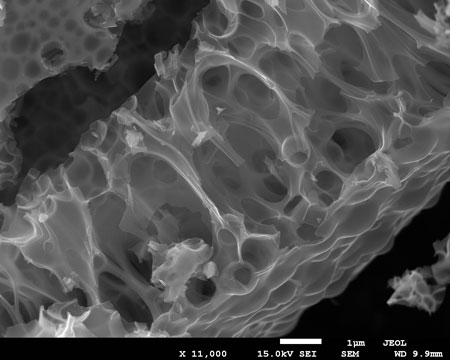| Posted: Oct 07, 2013 | |
Fuel cells from gelatin |
|
| (Nanowerk Spotlight) Platinum is the work-horse of many catalytic processes. It's become particularly important recently since it can drive key reactions in new technologies such as fuel cells or photoelectrochemical cells. However, platinum is scarce, difficult to mine and therefore very expensive. For instance, one of the biggest barriers to the adoption of fuel cells in hydrogen powered cars is their cost. Large quantities (about 30 grams) of this noble metal are still required for the electrodes in the fuel cells at which the chemical conversion processes take place. The pure platinum needed contributes about 40 per cent of the total unit cost. Without the catalytic effect of the platinum, it is not currently possible to achieve the necessary conversion rates. | |
| Researchers are working hard to find inexpensive alternatives to platinum catalysts for use in hydrogen fuel cells. Doped carbons were discovered to be a possible alternative to platinum-based materials about five years ago. This sparked a huge amount of interest in nanostructured carbons such as carbon nanotubes and graphene and many methods have been developed to prepare these materials (see for instance: "Graphene catalyst outperforms platinum in fuel cell" or "Unzipped carbon nanotubes could help energize fuel cells and batteries"). | |
| However, these methods generally involve relatively expensive reagents and complex or hazardous chemical processing. ‘Green’ or sustainable routes to platinum-free fuel cell catalysts have been published, but these generally result in a significant compromise in catalytic properties. | |
| A British-Japanese-Chinese research team has now developed a really simple route to carbon materials that perform almost as well as a commercial platinum/carbon in a key fuel cell reaction. To make these materials, they use gelatin – the same gelatin you'd use to make jelly/jello. | |
 |
|
| The gelatin-iron foam before it is heated to make the carbon catalyst. (Image: Dr. Schnepp, University of Birmingham) | |
| "The exciting thing about our research is that it is a really simple route to fuel cell materials with activity similar to commercial platinum/carbon," Dr. Zoe Schnepp, a Birmingham Fellow at the school of Chemistry, University of Birmingham, tells Nanowerk. "It’s a lovely proof that chemistry can be simple and safe and still result in complex nanostructures with great properties." | |
| Schnepp is first author of a paper in the October 1, 2013 online edition of Journal of Materials Chemistry A ("Doped-carbon electrocatalysts with trimodal porosity from a homogeneous polypeptide gel") where the team describes a versatile one-pot synthesis of nitrogen-doped carbons that exploits the templating ability of biological polymers. | |
| "The chemistry of the system is also really interesting" she points out. "We mix gelatin with iron and magnesium nitrates in water. The precursor is therefore a homogeneous solution. As the material dries it spontaneously foams. This relies on the magnesium and the iron crosslinking the gelatin to form a sticky resin and the nitrate reacting with the gelatin to produce gas bubbles. So the mixture forms it’s own intricate sponge-like structure. The sponge is then heated under nitrogen to 800°C, during which time the gelatin decomposes to carbon, the magnesium nitrate forms nanoparticles of MgO and the iron nitrate forms nanoparticles of iron carbide." | |
| "In itself this is really cool, since a homogeneous precursor would normally be expected to give a homogeneous product – in fact iron magnesium ternary oxides are fairly common as natural minerals." | |
| On top of this, iron carbide happens to be very good at converting amorphous carbon to graphitic carbon. This forms in onion-like layers around the iron carbide nanoparticles. When the material is washed with some dilute acid, the MgO and Fe3C nanoparticles are removed, leaving behind tiny pores in the carbon. Along with the sponge-like macrostructure, these give pores of three different length scales. | |
| The researchers point out that the really significant aspect about this system is that the activity is so high. They think this is a result of the complex nanostructure formed by all the different components. The bottom line result is the synthesis of a high-quality electrode material by really simple chemistry. This debunks the myth that 'green chemistry' equals 'inferior materials'. | |
 |
|
| A scanning electron microscope (SEM) image of the carbon foam. (Image: Dr. Schnepp, University of Birmingham) | |
| While this specific work was targeted at fuel cells, the whole issue of noble-metal replacement is a much broader challenge. For example, some of the best materials for splitting water in photoelectrochemical cells rely on platinum nanostructures. The research team's broad goal therefore is generating a family of materials that could have many applications in catalysis. | |
| "Obviously, there are huge challenges to the specific task of platinum-free fuel cells and we have a lot more testing such as longevity studies before our materials could get into a real device," says Schnepp. "But the gelatin fuel cell material is just one example in a much broader effort." | |
| She notes that 'sustainable routes to materials' was highlighted as a major global challenge by the Royal Society of Chemistry in its 2011 Sustainable Global Society Report. | |
| "Our research looks at addressing this issue using natural materials as precursors. Gelatin is a by-product of the meat industry and is a fascinating molecule. But we are also looking at seaweed for generating hydrogen and sawdust for water filtration." | |
 By
Michael
Berger
– Michael is author of three books by the Royal Society of Chemistry:
Nano-Society: Pushing the Boundaries of Technology,
Nanotechnology: The Future is Tiny, and
Nanoengineering: The Skills and Tools Making Technology Invisible
Copyright ©
Nanowerk LLC
By
Michael
Berger
– Michael is author of three books by the Royal Society of Chemistry:
Nano-Society: Pushing the Boundaries of Technology,
Nanotechnology: The Future is Tiny, and
Nanoengineering: The Skills and Tools Making Technology Invisible
Copyright ©
Nanowerk LLC
|
|
|
Become a Spotlight guest author! Join our large and growing group of guest contributors. Have you just published a scientific paper or have other exciting developments to share with the nanotechnology community? Here is how to publish on nanowerk.com. |
|
